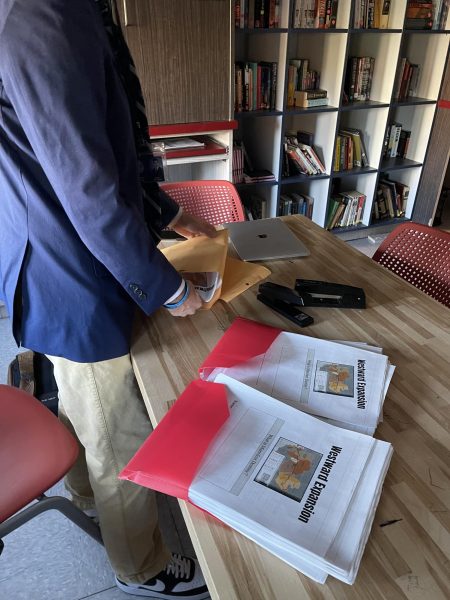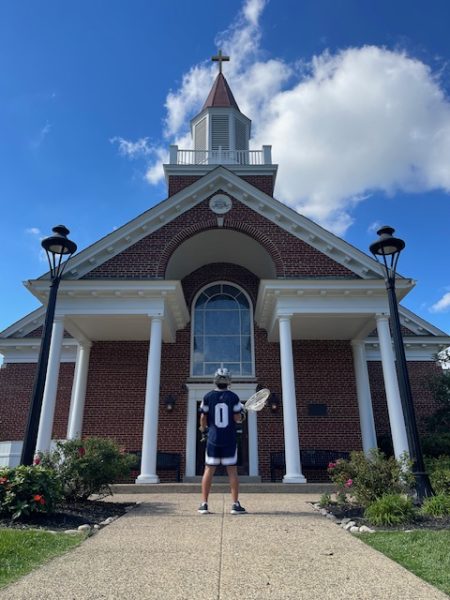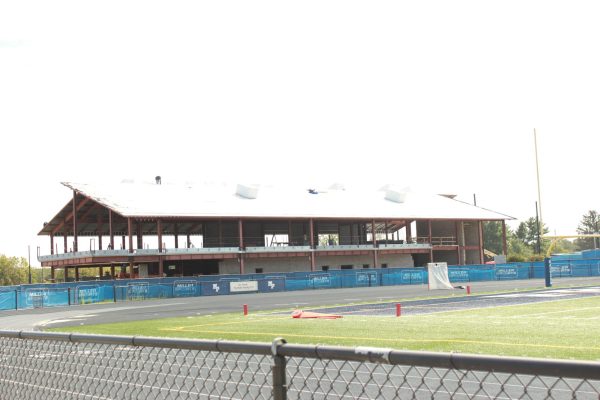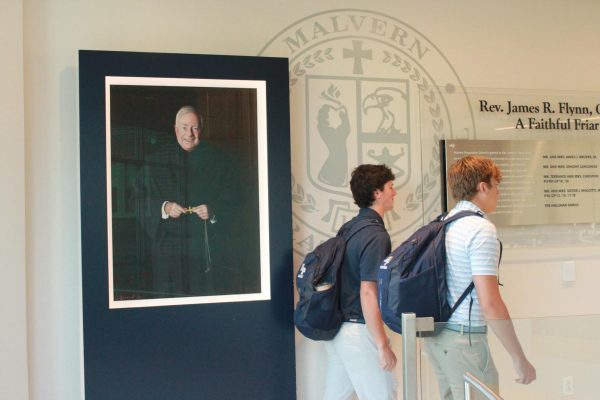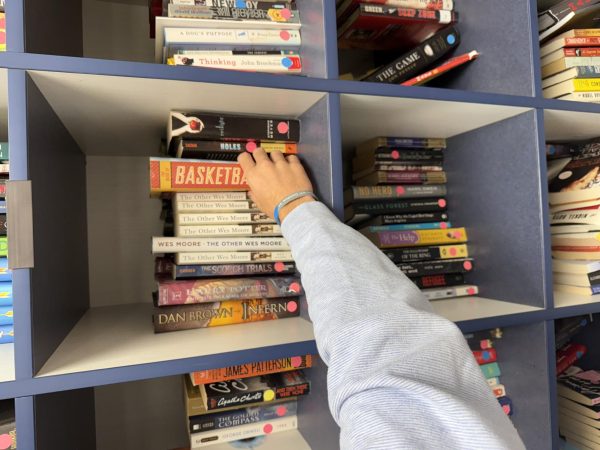Malvern Prep: Back from the pause
Malvern Prep is back open, at least partially. How the school got this far is another story.
“Dear Malvern Community, after much thoughtful discussion, the Leadership Team and I have made the decision to close our school campus and implement remote learning for the faculty and students. We have been preparing for this eventuality and we are confident that our faculty is prepared to deliver a high-caliber learning experience. Malvern’s campus will be closed beginning at 3:00 p.m. tomorrow, March 13. Our hope is to reopen the campus on March 30.”
That was the first postponement of classes from Head of School Fr. Donald Reilly. Malvern’s campus did not open on March 30, nor did the campus open on April 20. Like all schools in the nation, Malvern did not open for the rest of the 2019-20 academic school year. But began preparing campus and creating protocols that would allow Malvern to resume classes in Fall 2020.
Malvern eventually reopened with the guidance of the Administrative Response Team, a group that gave Reilly direction as to how to safely bring students back to campus. The Administrative Response Team was later dissolved once the school year started, and the chairs of those committees alongside Reilly, Mr. Paul Simpson, and Mrs. Elizabeth Malone continued their work as the Caritas Committee.
In order to obtain the best picture of what went on behind the scenes over the summer, the Friar’s Lantern spoke to each member of the Caritas Committee. These conversations provide insight into what it took to reopen Malvern, and the thoughts of those involved are documented here, divided by group and responsibilities.
The Big Picture
As the 2019-20 school year came to a close, Reilly realized that Malvern would need to begin preparations for the 2020-21 school year with the expectation that not all students could attend in-person classes. With this in mind, he set in motion the Administrative Response Teams.
“My job over the summer was to initiate a team of people to design what became The Malvern Guide for Parents and Students,” he said. “The Administrative Response Team, composed of 58 colleagues, met weekly to present their respective Team’s work for the publication and distribution of The Guide to the Malvern Community.”
To help with the oversight and management of the committees, Reilly asked Mr. Paul Simpson ’86, a longtime Malvern teacher and alumnus to take part in communication and planning between groups.
“[Fr. Reilly] felt he needed another set of eyes and ears to recognize that some of the work being done by one committee might be being repeated by another committee; or something that they’ve come up with an idea here, that people in this committee might need to know that information,” he said.
In order to help coordination between groups, Simpson attended every committee meeting and meetings of the Administrative Response Team chairs.
“Every committee met just about every week over the summer; and I attended all the meetings,” he said. “I would take information from one committee and say ‘This committee is working on this issue or this topic, we’re trying to address this.’”
“The decision wasn’t mine to make. I was just making sure that everybody had the full picture,” he continued.
Simpson’s job wasn’t easy, and by his account, the work tested him continuously. “It was definitely challenging, it tested my organizational skills,” he said.
The work done by Simpson and the committees that he worked with is now being carried out as Malvern reopens school and prepares to welcome more students back.
“Last summer’s work is now being implemented in a gradual and careful way to evaluate the effectiveness of The Guide,” Reilly said. “This approach requires observation, consultation, and adjustment to the plan to assure our top priority of safety and wellness is maintained.”
This far into the school year, Reilly says that he’s pleased with what he’s seen on campus, and believes that the Administrative Response Teams, now known as the Caritas Committee, has been instrumental in keeping students safe.
“As Head of School, I am pleased with the diligent work and passion the Leadership Team and the Caritas Committee [displayed in anticipating] situations on campus in order to prevent an obstacle that would keep the community from a quality experience,” he said.
While the arrival of students to campus is certainly a success, Simpson doesn’t want to call that the only success to come out of the Administrative Response teams.
“I think it’s an evolving thing,” he said. “There’s those victories that are the little things coming up.”
For Reilly, the continuation of students being able to come to school in person is certainly important, yet he still focuses on maintaining Malvern’s security against the virus.
“The best-case scenario is that compliance is taken seriously all day, every day, on-campus, off-campus. Assisting us in being COVID-free is living Friar Brotherhood,” he said. “All of us need to engage in self-care by adhering to protocols which, in effect, is the best care we can give others.”
Malvern’s best defense against the virus is the student’s motivation to stay on campus, Reilly believes, given that this motivation will make sure students follow protocols.
“The intense desire to be on campus and resume our common life suggests an equally intense cooperative effort to change anything in our life that would keep us apart with regard to the virus,” he said. “I believe these motivations are our biggest success.”
In working to reopen the school, Reilly found one of his biggest difficulties was the lack of resources due to this unprecedented situation being a first for educators and students. However, Malvern’s strength and resilience were enough to give Reilly the confidence to bring students back.
“There is no script, nor previous experience, or someone to whom we can turn for sage advice about the best response to this invasive, insidious, deadly, unseen plight,” he said. “What we do have is the assurance that as a faith-filled community of believers, something good either personally or communally will emerge from our current experience that will strengthen our mission and our role within the mission of Malvern.”
Wellness and Safety
The Wellness and Safety Committee has a total of eight members, each who bring a different opinion to the table. Dr. Dorothy Sayers along with Mrs. Korin Folan, Co-Chairs of the committee, recognized the diversity of the committee as playing an important role in the planning process.
“[The] reason for the team having diverse members [was] so we had someone from every angle of the school that could look at it. From Mr. Lestrange [thinking about] people coming onto campus and you had Mr. Gray looking at it from how are we going to serve lunch. So we tried to get representation from people from all across campus so we were making sure we weren’t missing any pieces” states Folan.
The job of the Wellness and Safety team was to implement proper guidelines for safety and well being before students and faculty returned to campus. One of those people is Malvern’s Chief of Police, Louis Marcelli, who informed the committee on whether or not their decisions were legal under state mandates.
“With the wellness and safety team, the goal was to create protocols and plans, taking into consideration all the things the CDC has said with the Chester County Department of Health,” Sayers said.
However, Sayer’s background as a psychologist also made her consider the emotional well being of everyone on campus.
“Because you’re taking into consideration not only the physical health [of students and families] in the space that we’re in but also the emotional pieces that go into it,” she said.
From a health and wellbeing perspective, Malvern’s reopening had its difficulties, often with keeping students on board with the plan.
“[The biggest difficulty is] educating everybody and making sure everybody’s doing their part,” she said. “I feel confident in what we did, and I think we have a really good plan, but it only works if everybody is doing their part, and reading the GPS and understanding what the rules are,” Folan said.
The COVID-19 pandemic also made the Wellness and Safety committee create a “culture shift” on campus to push the mindset of safety.
“We’ve created what those expectations of behavior are on this campus so that culture shift and mind shift is really the biggest challenge,” she said. “You’re used to walking really close to a friend, or shaking a hand, or hugging and that’s normal. We can’t do that.”
One of the most specific decisions handled by the committee was the question of whether or not Malvern should regularly test students for the Coronavirus. The committee opted against testing.
“We could test everybody, but then right after we test everybody they’re going to their own houses and are exposed to all different things,” Folan said. “The big concern is, we could test everybody, but we can’t guarantee everyone’s going to quarantine then for two weeks, or that people aren’t going to get exposed to things outside, like when they go home.”
Another member of the committee is School Nurse Elizabeth Malone, whose job is widespread.
“My job was to guide people on the committee to make decisions with everybody’s health and well being in mind. Particularly, social distance in the classrooms,” she said. “I wouldn’t say I specifically helped with one thing but the biggest part of that is getting kids into school, getting everybody checked in.”
Day-to-day, Malone speaks with teachers and parents about the ways to ensure safety for students on campus.
“Most of the phone calls are trying to help parents get on the app to make sure they’re able to use it correctly and consistently,” she said. “Then just [answering] questions on how we do things and why we do things.”
Malone is also the faculty member who will deal with any students that may come on to campus with COVID-like symptoms, by treating them and reviewing them in isolation.
“I would put them in the isolation room or we take their temperature, and I would be protected by myself with PPV. So I would already have a mask on, I have a shield. I would put on a gown and put on gloves just to make sure that I’m protected. And I would assess them, and I would call their parents to pick them up,” she described.
The Wellness and Safety committee had what was possibly the most difficult job of all the groups, but they believe that they were able to care for the entire Malvern community.
“Our job was to look at the entire school community,” said Folan. “We always had to come back to the common good.”
Teaching and Learning
No school can exist without providing an education for its students. As Chair of the Teaching and Learning Committee, it was Mr. Patrick Sillup’s job to find ways to provide students with the best education possible in an uncertain landscape.
“So this summer, the task was really, ‘How do we prepare faculty to design courses and deliver courses in an environment that is going to be ever-changing,’” he said. “’How do we get better from the spring, and then bring up the students.’”
Sillup recognized that students will spend a lot of time at home learning, which became something to prepare students and faculty for.
“Students are going to be on-site, students are going to be online, whether it’s because they’ve chosen to be online exclusively, whether it’s because they’re exhibiting symptoms, and they’re not going to be in school, or whether it’s because it’s just as we’re opening up, not their day,” he said. “So absenteeism, we knew was going to be a role, that was going to play a role. So we had to design [courses] with that in mind.”
Sillup’s committee, like all other committees, relied on other teams for communication and cooperation in certain areas, such as Brotherhood Days and how those would impact the academic schedule. Sillup also communicated with other Main Line area schools to learn and grow in Malvern’s preparation for the upcoming school year.
“I have also been connecting with other administrators in the area for courses for a pretty independent school rich area. Talking with them about ‘What’s learning design looking like for you, how are you working with faculty members, what is best practice?’” he said. “So, that was beneficial, we had a constant chat stream, essentially going and meetings happening as well; that was a big influence.”
As the school year began and his committee disbanded, Sillup’s job has changed from planning to executing. For his day-to-day, this means helping students and faculty along the way as they navigate the new school year.
“[My job] is very much rooted in being present and helping students navigate the campus, helping faculty navigate the different questions that just arise day-to-day. I’m looking at myself as a problem solver. And as someone who’s just going to try to ask as many questions as possible so that again everyone feels safe and secure, which is supposed to be the number one priority at all times,” he said.
Sillup is also working with Chinese exchange students who have remained in China and learning completely remotely for the time being.
“We’re in constant conversation… Counselors have done a fantastic job of staying in connection,” he said.
One of the most interesting things Sillup has noticed so far is how those who are at Malvern but still taking classes virtually are managing their situations.
“[Students] find a different seat within the space, some are going outside. Some are pulling up the table, they’re opening the screen, they’re putting on headphones, they’re jumping into the class… it’s very collaborative,” he said.
As Sillup notes, Malvern’s staff played a large role in helping students, something that impressed him deeply.
“I don’t know that there’s a perfect recipe right now for teaching and learning in this environment. I mean to the college level all the way down to kindergarten. But I do know that you can find teachers that really care about kids. I was just really humbled by the fact that we have a wonderful faculty who really cares about the students,” Sillup said.
Student Life and Augustinian Culture
In a school that pushes the idea of Augustinian ideals so much, a reopening would be remiss without some sort of spiritual facet. That’s where Student Life and Augustinian Culture comes in.
According to Co-Chair, Mr. Ronald Algeo, the idea for the committee came as Malvern tried to add spiritualism to a secular solution.
“Father Reilly was doing obviously a ton of research and one of the places he found a really great model was the Johns Hopkins Institute that talked about getting through a quarantine together as a school, and how to start reopening, what do you need to have,” he said. “One of the things they were missing was mission.”
One of the things that sets Malvern apart from other schools, as Algeo says, is Malvern’s values, something Reilly was invested in preserving. “He wanted to make sure that our mission was a part of our planning.”
What came about was Brotherhood Days, which take place each Wednesday and give students time to connect with their whole class, not a small faction.
The idea for the day came amidst general brainstorming, Algeo said, when the committee realized this new schedule didn’t provide a lot of room for student life.
“There are no special schedules, there are no AGE Blocks… So I asked a question to my team: ‘Do we make [Wednesdays] a school day, which we could, and logistically is probably easier, or do we want to own this day, and provide an experience for students that’s really deep and rich… [and] really Augustinian,’” he said.
The Student Life and Augustinian Culture Committee, or SLACC, spent a good portion of their time working on religious and spiritual commitments to students, which was spearheaded by Co-Chair, Fr. Chris Drennen.
“The spiritual life in the campus ministry and Christian service activities were going to find a place to live,” he said.
Drennen focused primarily on the religious aspect of the group: planning masses and Christian Service.
“We can’t do a school-wide mass, because we can’t fit 700 people in a room for a long time,” he said. “So every other week when you have Brotherhood Day, [students] will have an opportunity for a weekly mass.”
“We have a new Christian Service Director, Mrs. [Gabriella] Toth… so they’re using that time during Brotherhood Days to gather a few kids together to do some planning,” he said.
However, Christian Service will have to look different this year amidst the backdrop of a pandemic, given that certain opportunities won’t be available to students.
“It will be very different because we can’t go to work with the elderly, and because of the virus, we’re looking more toward planning to a time when we can go back to doing what we did before,” said Drennen. “Protocols are important to research and planning and seeing what the interest is.”
While Drennen spends his Brotherhood Days working on the religious aspect of Malvern’s mission, Algeo looks at how he can create student connections through other activities.
Algeo’s job composes mainly of physical activities and keeping students active. For Algeo, his role is to make sure that those involved have the support that they need.
“It’s as simple as money, equipment, space, time, supervision,” he said. “We’ve had to get people involved in terms of more volunteers to help with supervision, so students can still be spaced out, and still make sure that people are helping them to do those kinds of things.”
As Drennen notes, the process is all about being able to adjust and adapt, something that he hopes people are able to understand from an outside perspective.
“You have to have a little faith in God that we’re making the right decisions and faith in the people who are making the decisions and doing it,” he said. “People are trying to do their best. And we are willing to change when we realize there’s tweaks that we have to make.”
Finance, Building and Grounds
Every arrow, every piece of tape, every bottle of hand sanitizer, and every dollar spent was the duty of the Finance, Building and Grounds Committee.
“[Our job was] basically to prepare our campus for a response to the COVID pandemic and the requirements from the CDC as far as social distancing,” said Co-Chair Mr. Ted Caniglia. “We knew that there were going to be additional expenses to prepare the campus that were not part of our operating budget. We were not concerned about the cost associated with preparing our campus for social distancing.”
Caniglia’s Co-Chair, Mr. Jeff Kinney, had a team who took care of all the details in getting the physical details of campus ready.
“We report to Ted and let him know all the decisions that we’re making as far as getting the grounds ready, and getting all the buildings ready,” Kinney said. “We did all the labeling. We figured all that out and how many people we could have to stay within the guidelines of that six-foot rule.”
A large part of Kinney’s job was clearing out all the classrooms in Carney Hall, something he believed was a long time coming.
“Every single building was cleaned, then disinfected. So, that was all done during the summer months while everybody was out after we got everything relocated and everything put into place,” he said.
Malvern is also looking to utilize the entire campus and property.
“We also created a lot of outdoor spaces. Mr. Sillup went around the whole campus and figured out where the WiFi was still good,” Kinney said.
While not all of the space will be covered, Caniglia says that Malvern is making a few serious investments into ensuring that outdoor learning is comfortable, inlcuding purchasing outdoor tents for outdoor classrooms.
Malvern is currently looking to make sure outdoor learning can continue even in the winter, by ensuring that the tents purchased are protected against all weather conditions.
“We’re in the process of negotiating, and purchasing, a large 60 x 120 foot tent to cover the bottom two tennis courts, for which we’re also going to purchase lighting and heat so we can have classes in that area this winter to allow us to continue to follow the guidelines from the CDC,” Caniglia noted.
Kinney and Caniglia were also responsible for ensuring that the lunch process in Stewart Hall was safe for students to enjoy daily.
“If you go into our cafeteria you see that all tables have Plexiglass,” Caniglia said. “Now they’re going to be six students in each table, and also to spread them out so we can meet the requirements from the CDC for social distancing.”
With this change in seating, Malvern’s capacity in Stewart is now a fraction of what it was. “Whereas we can see almost 400 in the cafeteria, now the numbers 142,” Caniglia estimated.
As Kinney and his team were preparing the campus, the Finance, Building and Grounds Committee kept teachers in the loop as to the status of their classrooms.
“We had faculty meetings all throughout the summer, and we explained what that’s gonna look like. We gave them all opportunities to come and take their stuff and whatever they wanted to keep was moved to a different area,” Kinney said. “So they’ve been on board the whole time, they knew what we were doing.”
Towards the future, Kinney and Caniglia just have to make sure that Malvern’s reopening encounters as few bumps as possible.
“Our thing right now is to make sure that everybody and everything we put in place, continues to work as we projected,” Caniglia said. “And if there are any hiccups, we can make changes on the fly so that everybody is safe.”
Employee Relations
For every protocol put in place for students, there was another put in place for Malvern’s faculty and staff.
“The purpose of the committee was really to make sure that the health and safety of our employees was intact and as we brought people back on campus, not only students, but faculty and staff on campus, that we were creating a safe working environment for them,” said Committee Chair Mrs. Neha Morrison.
Morrison had to look at recommendations, guidelines, and student protocols to be sure that her committee was on track with what the other teams were doing.
“We were looking at the CDC guidelines very carefully and just using that as sort of our framework in terms of the policies and the protocols that we needed to put in place,” she said.
While students coming to campus complete forms on Magnus Health before they can come in, Malvern’s faculty and staff also have daily check-ins before they arrive on campus.
“The students go through Magnus, the faculty and staff go through a different system called Ruvna,” Morrison said. “So every morning, we all do the exact same thing that [students] do as well.”
As the Employee Relations Committee tried to set protocols for Malvern’s faculty and staff, the constant changes and alterations to recommendations from the CDC are what Morrison felt set them back.
“So it was the challenge that something would come out and then it would change,” she said. “That was always the challenge, sometimes we’re holding a pattern, we’re waiting to hear what we should or should not be doing.”
Another part of Morrison’s job was giving certain teachers, who were concerned about the effects of COVID-19, allowances to teach from home.
“We follow the CDC guidelines to allow for those accommodations,” Morrison said. “We are checking in, we do these check-ins with them every two weeks… That’s actually done by Mrs. [Beverly] Gordon… she has that responsibility to check in with those teachers to make sure that the student experiences just as good virtually as it would be.”
Teachers, like everyone returning to a somewhat normal life, had concerns about returning to campus. For Morrison, her team’s greatest success was in ensuring comfort for faculty and students through the protocols put in place.
“Definitely from faculty and staff, they are following those protocols and they’re very, very diligent about that,” she said. “So I think for me, that’s the biggest success is that we put these policies in place, and now people are listening and they’re following rules.”
A few weeks into the school year, Morrison sees success in what her team and herself have been able to accomplish.
“We’ve spent all summer just working really hard to make sure that we can open school and to make sure that, at least again from my perspective, that our employees and our students are safe and are coming to a safe environment,” she said. “So all of that just sort of came together beautifully.”
External Communications and Relationships
From the Malvern Weekly, to the Malvern Messages, to the Guide for Parents and Students, the External Communications and Relationships Committee told the Malvern community the decisions that were shaping the 2020-21 school year.
“What was really important to us was with everything that was going on with planning and decision making, how are we going to communicate to all of our different constituents what was happening?” said Chair Ms. Beth Alfonsi.
While Alfonsi’s team didn’t create any protocol, they did distribute the information that was given to them by the other teams.
“Where that really came to life is when a committee would say ‘We need to communicate this,’” Alfonsi said.
One of the committee’s priorities was to be able to consistently inform the Malvern’s families in ways that they were confident that the message would reach people.
“We decided we needed a certain frequency, we wanted the community to be able to count on a certain frequency of messages,” Alfonsi said.
“We also wanted to make messages that people wanted to consume. We started the Malvern Message, which is a video recording, because we know that videos get watched more than a really long document might,” continued Alfonsi.
Alfonsi and her team both knew that when Malvern families watched the Messages, the committee could include first-hand sources in their Messages.
“It also allowed us to feature some of the people that were making the decisions,” Alfonsi said. “It was nice to see and hear from who was making those decisions.”
While the team wanted to avoid the dullness of a large document, they recognized that a document would be needed to store all of the information being dispersed.
“The other thing that our group was tasked with was the Guide [for Parents and Students],” Alfonsi said. “So as all of the committees were working, what we were saying is ‘What does everybody need to know, in order to follow policies, protocols, what do they look like?’”
The Communications and Relationships team was both different from other groups in how they worked, and how long they had been working. While other committees were formed in May as the 2019-20 school year was winding down, the team had been working, unofficially, to communicate with the Malvern community changes taking place as the ‘19-20 school year progressed.
“[In] Marketing and Communication, we were trying to figure out from the beginning, like once in March, we all had to go, we said, ‘What do we need to communicate? How are we going to communicate it?’” Alfonsi said, comparing it to crisis communication.
The official Committee, like the others, has been disbanded, but the group is still working on providing updates to Malvern families through the Caritas Committee.
“Right now, we are listening for constant updates to the GPS… we’re also gathering content for the Weekly… And then we’ll be writing the script and reporting the Malvern messages on that every other week basis,” Alfonsi said.
For Alfonsi, one of her biggest motivators over the summer was the emails and communications she received from parents and students with questions about the process.
“We get the message@malvernprep.org. So, when we put out the Malvern Message, we [said], if anybody has any questions or comments, please email this,” she said.
“But emails like that, whether they’re positive or negative, I think it speaks so much to just how much of a community we are and how families care about their sons and care about this experience for them,” Alfonsi continued. “And I personally feel really lucky to be part of a community that is committed to figuring this out.”


